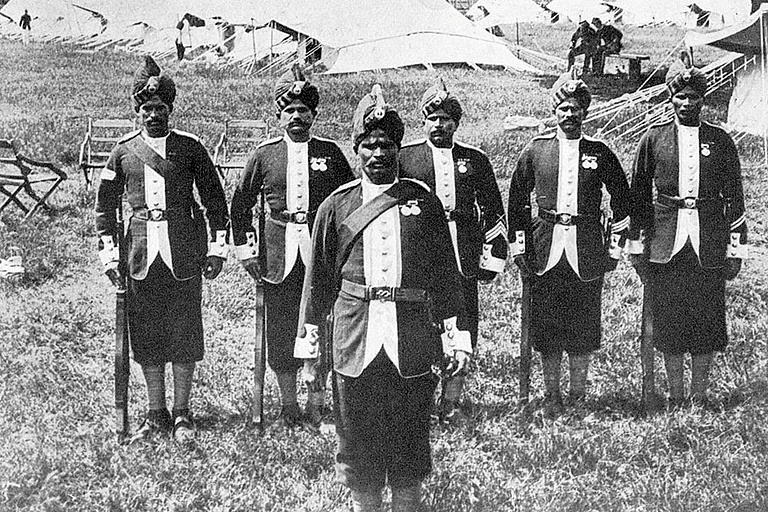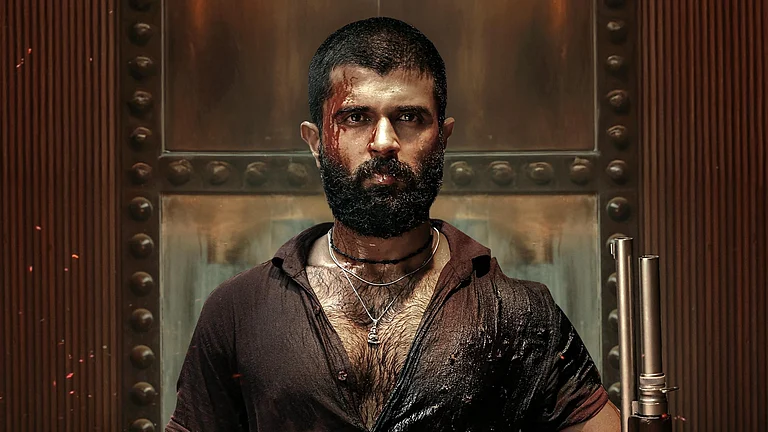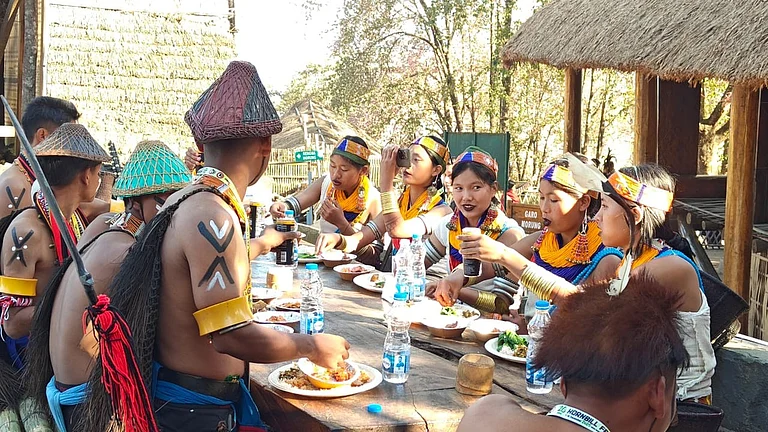Two lovers Kivigho and Kahuli were on their way to their native village. At a certain point, to get some fruit for his lady love, Kivigho climbed up a tree. But he could not climb down as the branches of the tree broke. Having been stuck there, slowly and gradually Kivigho turned into the Great Hornbill. A feather of the Hornbill fell on the lap of a heartbroken Kahuli. She treasured the feather for whole life in memory of her lost love, a Sumi Naga legend.
The hornbill, found in the sub-tropical regions of Africa, Asia and sub-regions of Oceania in the southwestern Pacific Ocean is central to symbols, myths, rituals and festivals for indigenous communities. In Nagaland, the Great Hornbill, one of the 55 variants of the bird, is associated with the legends of love, bravery and death. The sighting of a hornbill, hunting it down and donning its feather carries a special meaning in Naga folk belief.
For the Sumi Nagas, the legend of the Great Hornbill has made it a symbol of inseparable love. Hornbill is a black and white bird with a huge curved horny bill surmounted by a yellow casque with a tinge of red on its tip. The birds are considered monogamous, as they have only one partner in their entire lives, making them the perfect symbol of unending love and passion. They are also believed to be extremely caring towards their mates and children.
The Nagas were animist before the advent of Christianity in the 18th century and they used to worship certain creatures as spiritual beings. The Great Hornbill was one of them. J.H. Hutton, an English anthropologist and an administrator in the Indian Civil Services on his travel to then undivided Assam that included the Naga Hills, gave an account of Naga tribes who used to don the feather of the Great Hornbill in their traditional attire. In his letter to Henry Balfour, archeologist and the first curator of the Pitt Rivers Museum, Hutton gave an account of how the different ways of donning the Hornbill feather among the Renmas and Angamis had different significance.
“The design on the Rengma cloth I sent that looks like this: (SKETCH) it is at the top of some of the figures where others wear what seem to be hornbill feathers) represents 'A' an enemy's head and 'B' hair ornament such as those worn by Angamis in their ears. Such at least is the Rengma account, but the design strongly suggests to me the horned and hair fringed hats worn in the Angami tribe by old veterans with many exploits to their credit instead of the plain hornbill feathers worn by younger warriors...”
According to him, Naga tribes like the Changs and Konyaks and Phoms also used to wear horned hats and other tribes could have done so too at some time or other.
“The Rengmas nearly always seem to wear hornbill feathers in threes, though sometimes in twos, the apparatus for a middle one being present but the feather absent.” says Hutton in his account.
Similarly, J.P. Mills, another ethnographer in his travel to the Naga region back in the early 20th century, mentions about the carving of conventionalised figures of hornbills in the grave of a priest belonging to the Lotha tribe.
From these two accounts, it is evident that in early Naga societies, the native bird hornbill was celebrated as the symbol of bravery and sacredness. According to Naga legends, the virtuosity of a Naga hunter is determined by the way a hornbill falls off. If a hornbill falls on its tail first, thus bending and damaging the prized patterned tail feathers, it means the hunter did not deserve to wear the feathers as a sign of bravery. On the other hand, if it falls in a way that its feathers are intact, for example on its beak, the hunter is considered worthy of wearing the feathers.
There is also a myth that if a hornbill feather is worn by someone, who is not worthy of it or who is not a true warrior, the feathers will pull down or fall off. Thus, wearing a hornbill feather in traditional headdress signifies prestige and honour, a practice that is showcased in the Hornbill Festival. However, it is mostly replaced by artificial feathers due to the near extinction of the bird in the state.
Speaking to Outlook, writer and historian Tatongkala Pongen says, “The use of the hornbill symbolically by the Nagas in their ornaments, headgears and shawls is not only a sign of admiration but also seen as a matter of prestige and pride. There are several folktales relating about the bird and every tribe has their own version. For instance, one such folktale of the Ao tribe talks of the war between the Nokrang village and Longkhum village, which continued for hundreds of years, and it started because of the bird.”
The Hornbill is also regarded as an intervention of divine justice among certain Naga tribes. In another version of a folktale of the Liangmai Nagas, there is a boy called Talungding. The young boy is mistreated by his stepmother, who makes him toil hard in their Jhum and yet does not give him food. While working in the fields, he would see hornbills flying across the sky and wish to become one to be free. One day, his wish is granted and he turns into a hornbill. After years, there is a marriage feast hosted back in his village. The boy-turned-hornbill decides to make an appearance. When he starts circling around the village in the clear blue sky, the villagers become happy seeing a beautiful hornbill. He drops a feather to the host family. On seeing the beautiful feather, his stepmother also asks him to give her one feather. The hornbill tells the stepmother to close her eyes and open her mouth. When she does, the hornbill drops one of his feathers in her mouth, splitting her throat. The wicked step mother drops dead.
Death rituals of the Ao Nagas and afterlife stories are also inspired by the bird. Many believe that the soul takes the shape of a hornbill after death and that sighting a hornbill is a good sign of prosperity, especially during the harvest time. Despite their immense importance in the folk life of the Nagas, the hornbills are an endangered species in the state due to their widespread hunting inspired by legends.
Abraham Lotha, an anthropologist from Nagaland, has extensively used Naga folklore including those about the hornbill, while trying to bring freshness to a widely talked-about subject of Naga nationalism, self-determination and the nation state. In his book, Hornbill Spirit: Nagas Living Their Nationalism, he has compared the everyday lives of the Nagas with that of the hornbill—free spirited, determined and brave, but constrained by complex socio-political situations. Like the bird, the present state of the Nagas is a test of resilience in a fast changing world.


























